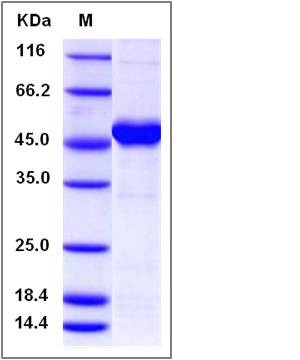Human MAX / MYC associated factor X Protein (His & GST Tag)
bHLHd4
- 100ug (NPP2334) Please inquiry
| Catalog Number | P12885-H20B |
|---|---|
| Organism Species | Human |
| Host | Baculovirus-Insect Cells |
| Synonyms | bHLHd4 |
| Molecular Weight | The recombinant human MAX /GST chimera consists of 397 amino acids and has a calculated molecular mass of 46.1 kDa. The recombinant protein migrates as an approximately 73 kDa band in SDS-PAGE under reducing conditions. |
| predicted N | Met |
| SDS-PAGE |  |
| Purity | > 92 % as determined by SDS-PAGE |
| Protein Construction | A DNA sequence encoding the human MAX (NP_002373) (Met1-Ser160) was fused with the N-terminal polyhistidine-tagged GST tag at the N-terminus. |
| Bio-activity | |
| Research Area | Cancer |Signal transduction |Akt Pathway |Transcription Factors in the Akt Pathway |
| Formulation | Lyophilized from sterile 20mM Tris, 500mM NaCl, pH 8.0, 10% gly 1. Normally 5 % - 8 % trehalose, mannitol and 0.01% Tween80 are added as protectants before lyophilization. Specific concentrations are included in the hardcopy of COA. |
| Background | MYC associated factor X contains 1 basic helix-loop-helix (bHLH) domain and belongs to MAX family. It is highly expressed in the brain, heart and lung while lower levels are seen in the liver, kidney and skeletal muscle. MYC associated factor X can form homodimers and heterodimers with other family members, which include Mad, Mxi1 and Myc. Myc is an oncoprotein implicated in cell proliferation, differentiation and apoptosis. The homodimers and heterodimers compete for a common DNA target site (the E box) and rearrangement among these dimer forms provides a complex system of transcriptional regulation. MYC associated factor X may also repress transcription via the recruitment of a chromatin remodeling complex containing H3 'Lys-9' histone methyltransferase activity. Multiple alternatively spliced transcript variants have been described for MYC associated factor X gene but the full-length nature for some of them is unknown. |
| Reference |
